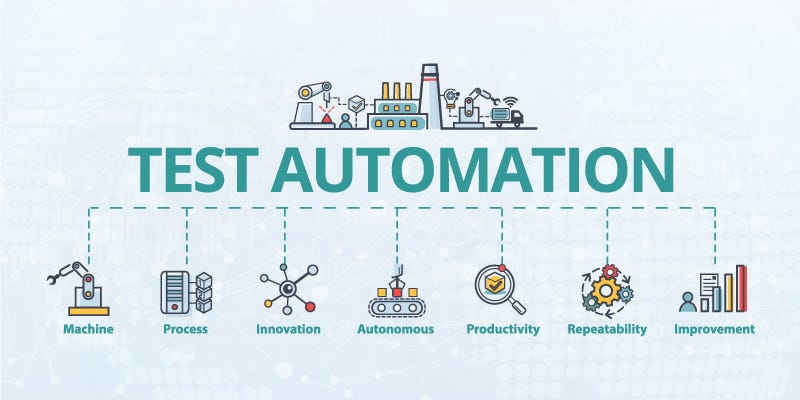Automation Testing Methods: Finest Practices for Seamless Assimilation
Automation Testing Methods: Finest Practices for Seamless Assimilation
Blog Article
From Guidebook to Automated Testing: A Comprehensive Overview to Transitioning Smoothly and Effectively
In the world of software application testing, the shift from manual to automated procedures has actually become a significantly crucial transition for organizations seeking to improve efficiency and precision in their testing techniques. As innovation proceeds to advance, the requirement for seamless and reliable computerized testing methods has actually never been much more pressing. The trip from handbook to automated screening is not without its difficulties, but when approached strategically and with a clear strategy in mind, the advantages can be substantial - automation testing. In this thorough guide, we will certainly discover crucial actions and considerations essential for an effective shift, from the preliminary option of tools to the assimilation of automation into existing workflows. Stay tuned to discover the insights that will aid lead the way for a smoother and extra effective testing process.
Benefits of Automated Examining
Automated screening uses numerous benefits, improving performance and accuracy in software program advancement procedures. One key benefit is the considerable decrease in screening time. Automated examinations can be run at the same time on several tools and operating systems, dramatically quickening the screening phase compared to hands-on testing. This enhanced efficiency permits faster responses on the top quality of the software program, allowing developers to recognize and attend to concerns promptly.
In addition, automated screening makes sure a greater degree of accuracy in detecting issues. Since automated tests adhere to predefined scripts, human mistake is minimized, bring about even more dependable examination outcomes. Consistency in screening is additionally improved, as automated examinations implement the very same steps specifically each time they are run. This uniformity is essential in making certain that all performances of the software application are completely checked, decreasing the possibility of undiscovered bugs sliding with to production.
Choosing the Right Tools

First of all, analyze your goals and needs. Understand the range of your project, the technologies involved, and the skill set of your team. This analysis will aid you establish the capacities and attributes you need in your testing devices.
Secondly, take into consideration the compatibility of the tools with your existing systems and processes. Smooth combination with your present software program development lifecycle is vital to ensure a smooth shift to automation.
Additionally, examine the scalability and flexibility of the tools. As your testing needs progress, the devices need to be able to adjust and suit modifications effectively.
Last but not least, consider the support and community around the devices. When implementing automated screening, durable assistance and an energetic individual community can give beneficial sources and assistance. By meticulously taking into consideration these facets, you can choose the right devices that straighten with your demands and established the phase for a successful shift to automated testing.
Creating Reliable Test Manuscripts

When crafting examination manuscripts, it is vital to take into consideration the certain requirements of the software program being tested and make certain that the manuscripts deal with all important performances. Clear and detailed naming conventions for test scripts and examination instances can enhance readability and maintainability. Furthermore, including mistake handling mechanisms within the test scripts can assist in identifying and dealing with problems quickly.
Additionally, organizing examination scripts right into modular components can improve reusability and scalability, decreasing redundancy and enhancing effectiveness in examination manuscript maintenance. Regular evaluations and check my site updates to evaluate manuscripts are important to keep speed with developing software needs and capabilities. By complying with these concepts, testers can produce efficient and robust test scripts that add substantially to the success of automated testing processes.
Integrating Automation Into Workflows
Effective combination of automation devices right into existing operations streamlines procedures and boosts productivity within software program growth cycles. When incorporating automation into operations, it is essential to identify repetitive tasks that can be automated to conserve time and decrease human mistake. By seamlessly integrating automated screening devices like Selenium or Appium right into the software program advancement lifecycle, groups can attain faster feedback on code adjustments, leading to quicker pest detection and resolution. This integration enables for continual testing throughout the advancement process, making sure that any kind of problems are identified early, causing greater software application high quality. Furthermore, automation can be used to set off tests immediately after each code devote, offering immediate validation and liberating testers to concentrate on more complex situations. Proper combination of automation devices calls for collaboration in between growth, screening, and operations groups to establish a unified process that maximizes effectiveness and performance in delivering high-grade software.
Guaranteeing a Smooth Transition
Efficiently transitioning to automated screening entails meticulous preparation and careful implementation to reduce interruptions and make the most of performance in the software application growth procedure - automation testing. To make certain a smooth change, it is important to start by carrying out a complete analysis of the existing testing procedures and identifying locations where automation can bring one of the most significant benefits. Engaging with all stakeholders early on at the same time, consisting of programmers, testers, and job supervisors, is crucial for amassing assistance and buy-in for the automation campaign
Communication is essential throughout this change phase. Clear interaction of the goals, advantages, and assumptions of automated testing assists to handle any kind of resistance or issues that might develop. Additionally, supplying adequate training and sources for employee to upskill in visit this website automation tools and techniques is vital for making sure an effective shift.

Verdict
To conclude, transitioning from guidebook to automated testing provides many benefits, review including increased performance and reliability. By choosing the suitable tools, creating reliable test scripts, and integrating automation effortlessly into workflows, companies can guarantee a effective and smooth transition. It is important to embrace automation as a valuable asset in software application testing procedures to improve overall high quality and performance.
In the realm of software application screening, the change from handbook to automated procedures has actually come to be a progressively crucial transition for organizations looking for to improve effectiveness and precision in their testing methods. Automated examinations can be run simultaneously on several devices and running systems, considerably speeding up the testing phase contrasted to hand-operated screening. Consistency in screening is likewise improved, as automated examinations implement the exact same steps exactly each time they are run.To guarantee the effective application of chosen testing devices, the creation of reliable test manuscripts plays an essential role in confirming the functionality and performance of automated procedures - automation testing. By adhering to these principles, testers can produce effective and durable examination scripts that contribute significantly to the success of automated screening procedures
Report this page